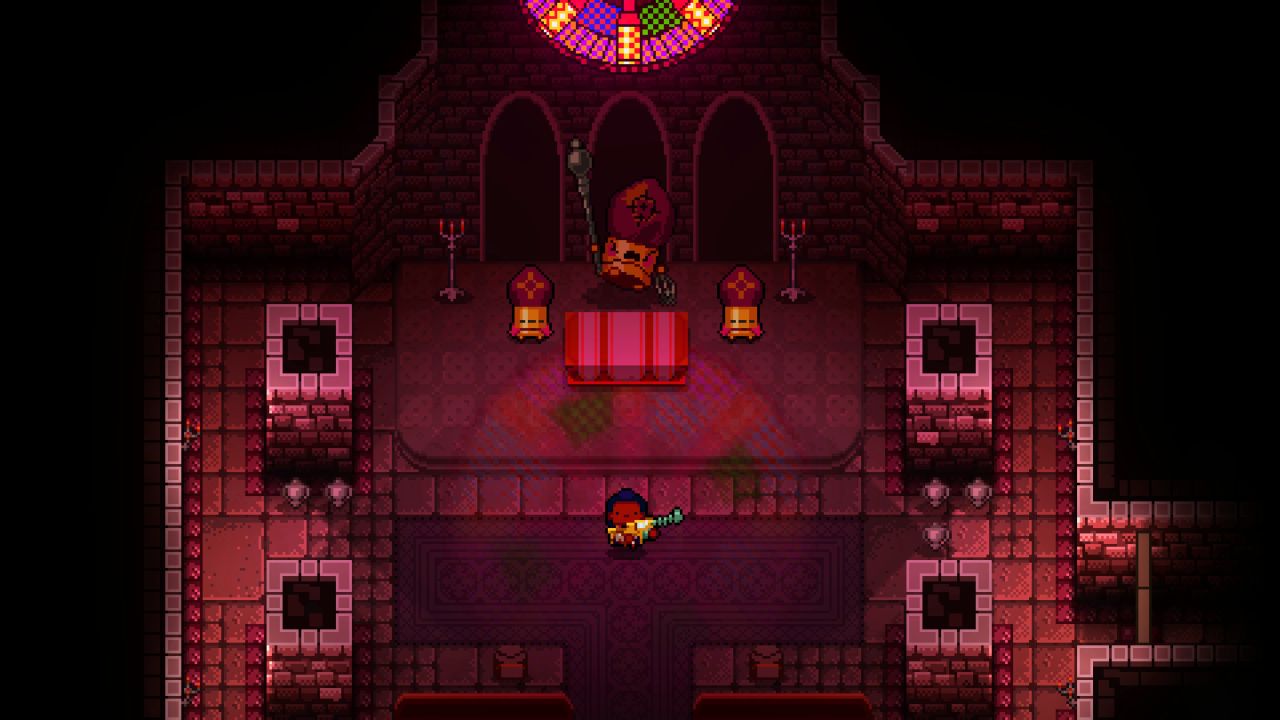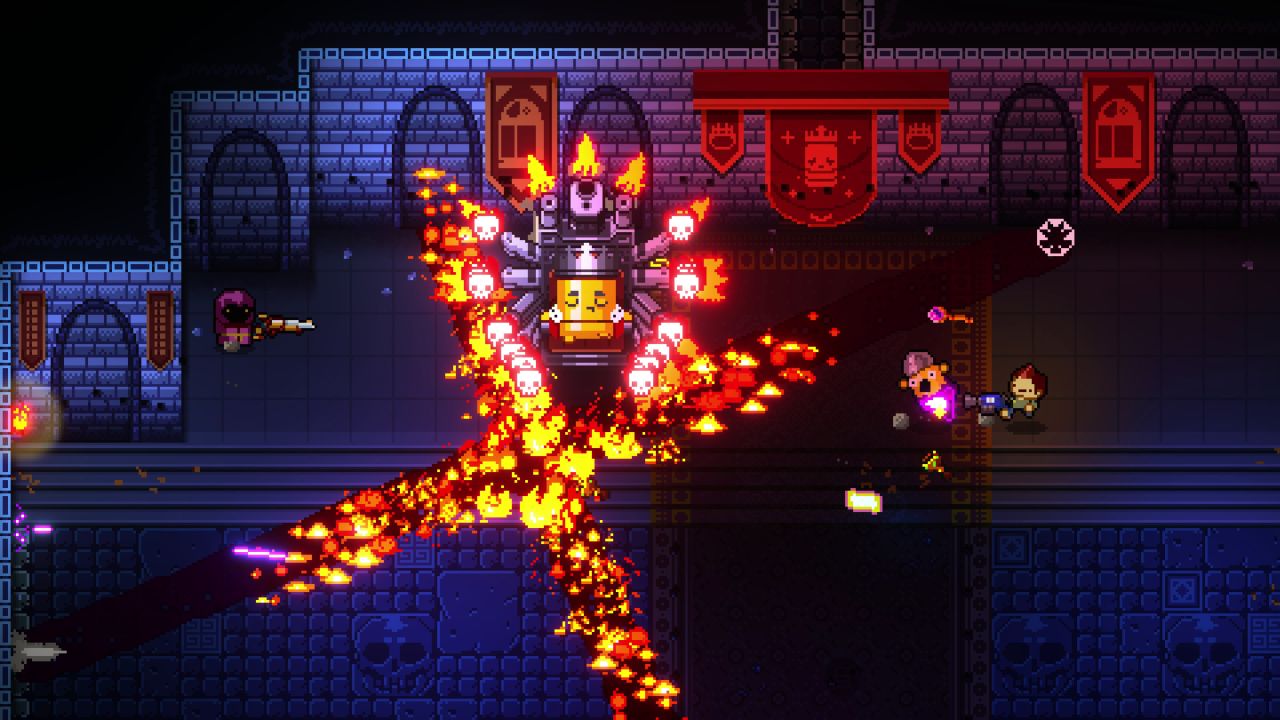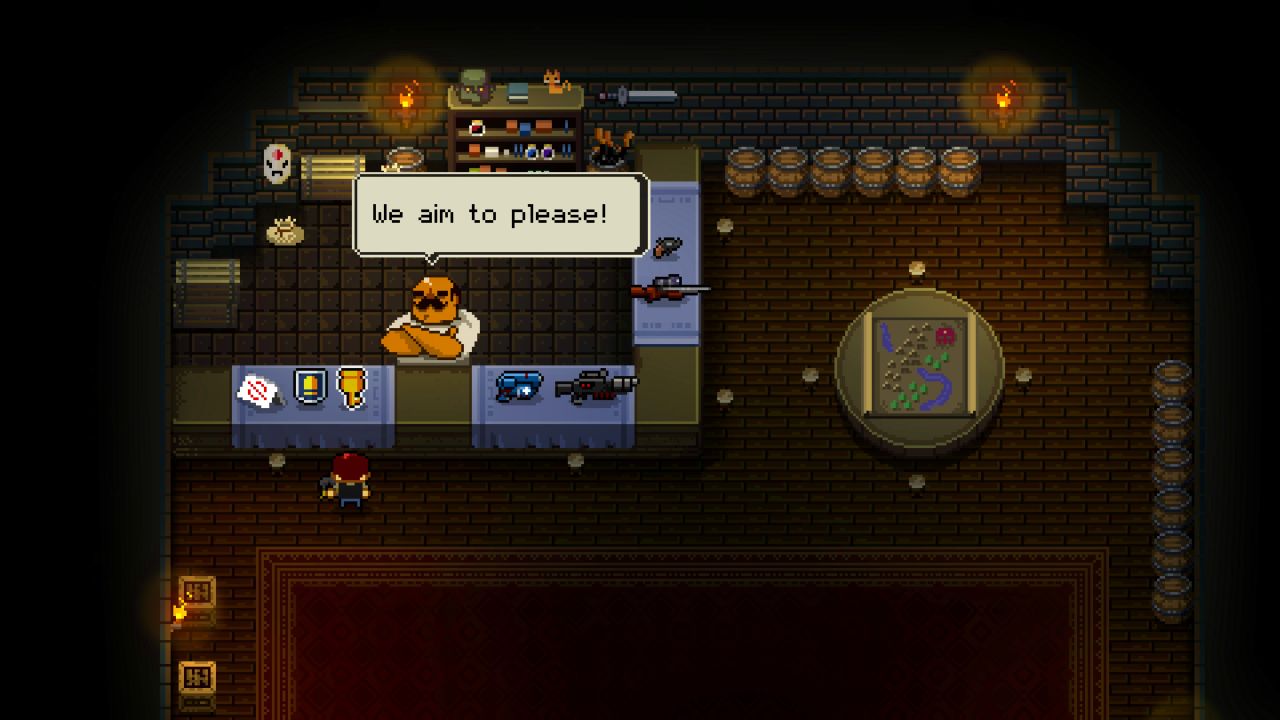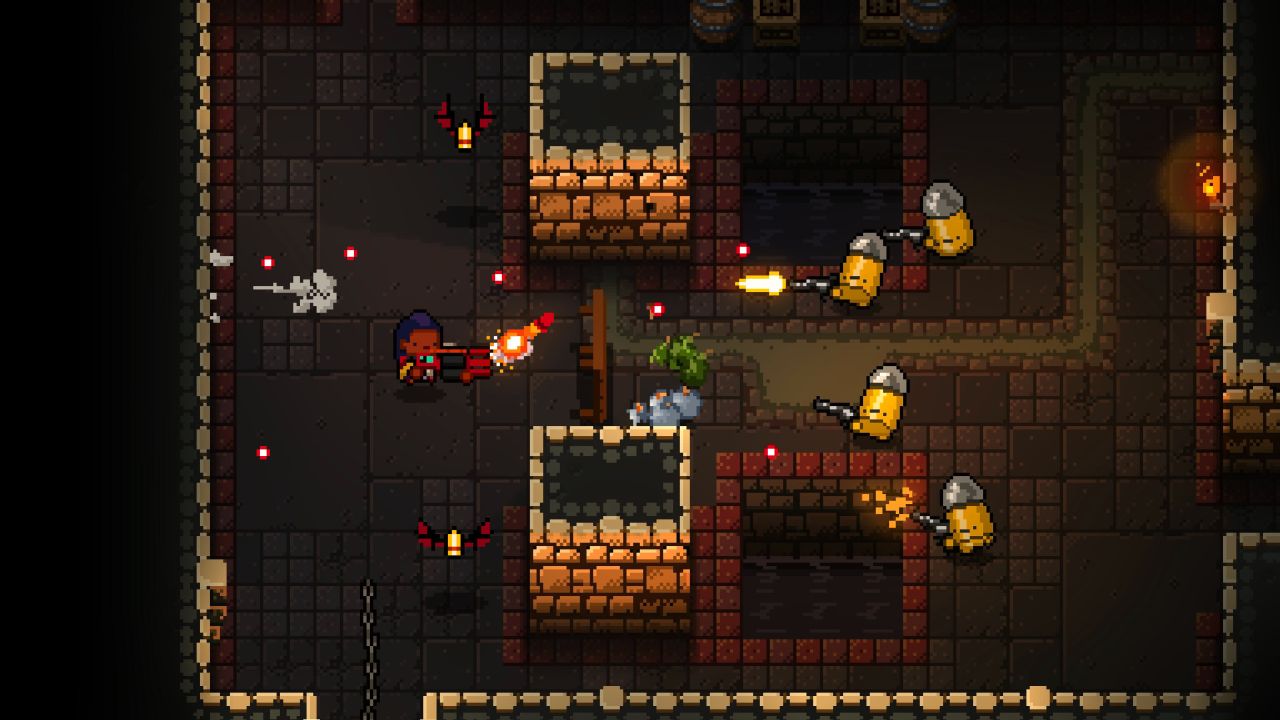Enter the Gungeon Review
I'm going deeper gunderground
Having spent the vast majority of my life living in a country where procuring a gun is marginally more difficult than procuring a complete fossilised Tyrannosaurus Rex skeleton (Australia), I’ll admit I often had trouble empathising with the kinds of people who obsess over them like exotic cars or anime waifus. “Why are you fascinated with the minute details of this thing?” I would wail in the confines of my skull, usually more than a little bit uncomfortable. “Don’t you know it’s for killing people?” It wasn’t until falling down a bottomless rabbit hole of Wikipedia articles that I developed an understanding: guns are incredibly varied and complex, and in a large number of cases, astoundingly silly. Yes, it turns out that there are a near-infinite number of ways to propel lethal projectiles out of a metal tube, and every single one has probably been tried at some point by some innovative person with a shed and a death wish. Take the Nock gun, a seven-barrelled flintlock rifle—intended to be fired from a ship’s rigging, of all places—whose recoil frequently broke the shoulder of whoever fired it. Take Mons Meg, a Scottish medieval cannon so ludicrously large and heavy that the residual heat generated by its powder charge limited its firing rate to 8-10 shots a day. Heck, take the Cold-War-era APS underwater assault rifle, which did exactly what it said on the box… provided that your target was close enough to see the uncomfortable rubbery crotch bulge in your diving suit.

None of them, however, compare to the mad landslide of weapons that fill Enter the Gungeon, a game whose title ought to tell you everything you need to know about its nature (and, for that matter, the nature of the minds behind it). It's the distant spacefaring future again, and over the dying embers of a space-campfire, hardened pilots tell tales of the legendary Gungeon: a constantly-shifting fortress on a distant planet, full of guns, gun-themed treasure, strange gun-themed magic, and unwelcoming gun-themed denizens. Yep, we're doing the classic roguelike setup again, strap yourselves in. You control one of four people, each with their own starting kit and motivation for entering the Gungeon—the Convict, the Pilot, the Marine and the Hunter—and your ultimate goal is the labyrinth's most heavily guarded treasure: a gun that can kill the past.
Hold on a second, how does that work? What do you mean 'kill the past'? You can't cap an abstract concept in the head. Does it kill things in the past? Does it kill historical events? What does a dead past even look like? Wouldn't a gun that changes the past be more effective? Oh, stop looking at me like that, I'm getting in the bloody elevator. You'd better have an explanation waiting for me at the bottom, though.
Structurally at least, Enter the Gungeon bears closest resemblance to the carefully-disguised slot machine that is The Binding of Isaac: you enter a room, you get locked in, you kill all the enemies, you sweep up all the health and treasure you can, then you repeat until you've cleared out the floor. Some rooms have chests, some have traps, and of course, you're not going to be able to descend until you find the floor boss and give its head a few extra ventilation holes. Variety, also much like in The Binding of Isaac, is achieved by dumping a few metric tons of content in a cement mixer and hitting the power switch, a somewhat inelegant approach that works fine and dandy as long as you can supply the sheer necessary volume in the first place. In Enter the Gungeon's case, that content is guns. Guns as far as the eye can see. Guns grazing in the meadows and roosting in the trees. If guns were characters, then the depths of the Gungeon would be the setting for a seventeen-hundred-page ultimate crossover fanfiction written by somebody who just didn't know how to stop. AK-47s and Desert Eagles sit alongside nailguns and weaponized mailboxes in the kind of collection that makes you wonder how many weeks of development were spent with the entire team lounging around in somebody's living room, pitching weapon ideas at one another until the sun went down. Alright, to be fair, most of them don’t have quite the same dramatic effect on the combat as they do in, say, Crypt of the NecroDancer - coincidentally, another excellent roguelike full of puns and enemies designed around a very specific theme - but there’s such a ludicrous number of them that you’re bound to find at least one or two per run that are unique enough to alter how you play, which is really what matters here.

But what are we really getting into, combat-wise? Enter the Gungeon self-identifies as a ‘bullet hell' dungeon crawler, and while that might be a bit excessive given how forgiving the game is of being hit—think of it as more of a ‘bullet hellhole’, or a ‘bullet somewhat-characterless-northern-suburb’—shmups mostly live in a strange subterranean gaming netherworld that never really gets acknowledged by the wider community, so it’s always nice to see a developer return from a spelunking expedition into that particular niche with a couple of pilfered ideas under one arm. Combat is chiefly characterised by a fetishisation of the dodge roll mechanic outdone only by Dark Souls—understandable, given the studio’s name—along with a constant, delightful flow between firing, reloading and evading that gently massages your brain’s split-second decision-making department the whole way through. The game foregoes the breakneck speed of Hotline Miami or Nuclear Throne in favour of a slower, messier, more chaotic, ‘kick over tables, break things, drop pianos on people' approach, and while that’s all well and good, it doesn’t always gel smoothly with the intense levels of concentration necessary to weave through intricate overlapping mandalas of bullets. Often I found myself getting blindsided by enemies I hadn’t even noticed amongst the clutter, or getting stuck on inconveniently-placed tables, or simply being momentarily dazed by a chain of explosions that covered half the screen. Like any self-respecting shmup, the bullets show up in dazzling colours that stand out like stoplights against the densely detailed backgrounds, but no such convention applies to the enemies themselves—some of which love to simply tackle you at frightening speed—or the pools of oil that can suddenly appear underfoot, ready to char-grill your toes at the first sign of a spark.
What I do really like about Enter the Gungeon, though, is that it somehow managed to subvert my natural gaming instinct to be as frugal with ammo as humanly possible. Theoretically there’s no reason why you can’t beat the whole game with the pathetic infinite-ammo pea-shooter you begin each run with—and I dare say that by the time this article has beamed its way across the internet into your eyes, somebody will have done exactly that—so of course, the natural strategy is to plink away at everything with it while hoarding a growing stockpile of much more powerful (and entertaining) weapons in preparation for the moment when everything goes to Hell. It’s the slow, tedious, safe approach that countless games have unwittingly trained us to take, but Enter the Gungeon turns it all around with a remarkable display of generosity. The game is like an extravagant wealthy party host, handing you full ammunition refills at such frequent intervals that even the stingiest of players are bound to start experimenting with their arsenal. Normally this kind of approach would be bookended by the snapping sound of somebody breaking the difficulty curve over their knee, but the game is able to consolidate slack ammo management with a reasonable challenge because your real adversary—as it rightfully should be—isn’t your own backpack space, but the hailstorms of bullets coming towards you, and the way you decide to deal with them. If you can’t handle those, no weapon is going to help you.

That having been said, the game does occasionally fall into the classic trap of putting you at the mercy of the roll of the dice. The Binding of Isaac was much guiltier of this, but it wasn’t always quite as apparent because the game allowed you a certain amount of fuzzy unreliable exchange between its various currencies: you could blow up a cluster of rocks if you had an excess of bombs but no keys, or donate your blood to a dubious medical machine if you had plenty of health but no money. In Enter the Gungeon, the vast majority of chests—that is to say, your primary source of new guns and upgrade items—can only be opened with keys, which in turn can only be sourced from the contents of the dungeon shop or rare enemy drops, both of which are entirely governed by the whim of complete and utter chance. One of my identifiers for a good roguelike is one in which reasonably sufficient skill and knowledge can eventually weather the capricious waters of the random number generator, and while I do believe that Enter the Gungeon deserves a glossy little rosette for satisfying that category, it still hurts to be taking on the third-floor boss with a literal peashooter because you’re so heavily dependent on being drip-fed keys for character growth. Fortunately, that kind of situation isn’t a regular occurrence.
Or maybe it is, and I’m just easily placated by cute designs and flavour text. There’s a strong current of charming, humourous presentation running through the whole game, manifesting in everything from the outlandish visual gag weapons to the item descriptions that paint an image of a galaxy gone mad. The Gungeon is not merely a place where a lot of guns can be found; it is a devoted monument to every aspect of them, and it manages it all while keeping a fluffy, lighthearted tone. This is the kind of game where you’ll legitimately fight sentient shotgun shells, squealing happily and tottering around innocently on stubby little legs, like the mascots of an incredibly inappropriate NRA-sponsored children’s TV show. So many tiny details are wrapped up in the subtleties of the animations, from the gentle bobbing of the Pilot’s slick pixelated hair to the defeated sobbing of a particular boss’s right-hand man, and it all adds up to a game with enough character to blow its competitors out of the water.
Strangely, though Enter the Gungeon is mostly just a nicely-assembled conglomerate of familiar parts, there is one area where it feels genuinely innovative: convenience. Dungeon crawlers have always put a bit more emphasis on the ‘crawl’ part than necessary, and while the new wave of roguelikes has done a lot to sand down the features that made their forebears so slow and clunky, the mere existence of randomly-generated floors usually means swallowing a steaming load of backtracking somewhere down the line. Not so in Enter the Gungeon. I was initially confused when the tutorial instructed me in the use of a teleporter—an enormous green floor pad shaped like a six-shooter’s cylinder—but it became clear why when I entered the game proper and discovered that they were scattered around the floor like Smarties on a spoilt child’s birthday cake, with extra teleporters located in the shop and outside the boss’s room. Floors tend to be large, sprawling affairs, but at any point you can pull up the map and whisk yourself away to a teleporter pad at absolutely no cost, enabling you to aimlessly explore freely without worrying about having to trek back to a room later to try another exit. This does come at the cost of making a lot of environmental hazards seem a lot less threatening—trap rooms only need to be beaten once, after which they can usually be skipped thoughtlessly past for the rest of that floor—but given how much downtime it trims out, I’m willing to give it a pass.

“Hold it right there, Enter the Gungeon”, I say, catching it with the curved end of a cane as it begins to nervously shuffle offstage. It thinks it’s getting out of here with a resounding recommendation (and between you and me, it’s right), but there’s one last thing to take care of: permanent progression. I’ve made it clear many times in the past why doing this to roguelikes is a poor idea—quick refresher: learning experiences that allow you to beat your head against the wall until the bar is lowered are self-sabotaging—but to be honest, Enter the Gungeon’s approach doesn’t so much disappoint me as just sort of make me scratch my head. You can add new weapons and items to the dungeon’s rotation by buying them between runs—assuming you scavenged enough space-credits off that last boss’s corpse, of course—but the pool of weapons and items is so large to begin with that it doesn’t really feel like your purchases are actually changing anything, especially not when most of them are sidegrades more than straight improvements. It doesn’t negatively impact the game; it’s just a pointless vestigial element, like the Scroll Lock button or the bloke who made Minecraft.
And that's it. Whatever minor missteps Enter the Gungeon may make, the end result is a game that has me vigorously slamming the 'restart' button at the end of every run, eager to get back into the fray. It's no great pioneering innovator, and its roguelike elements may not be subtly designed compared to the likes of, say, Spelunky, but they work well enough to make every chest an enticing prospect, potentially hiding a new silly way of dispatching one's foes in a combat system that leaves Edmund McMillen's baby-killing simulator in the dust. So if you're tired of seeing your own expression mirrored in Isaac's despondent face, and those long sessions of Nuclear Throne are beginning to give you a dash of radiation sickness, simply spin the cylinder of reasonably well-advised consumer purchases and pull the trigger on Enter the Gungeon.
 Comments
Comments












